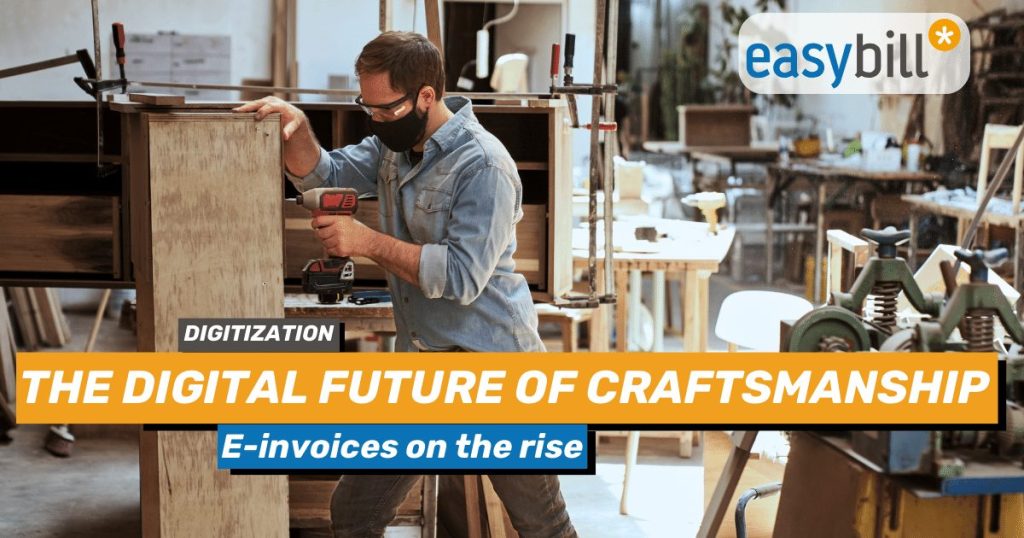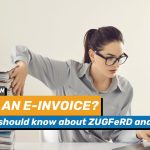
Digitalization is finding its way into all sectors. The skilled trades sector is no exception. E-invoices, i.e. electronic invoices, are gradually gaining in importance. But why should tradespeople jump on this bandwagon? In this article, we look at the benefits, challenges and solutions relating to e-invoices for tradespeople.
Many companies in the skilled trades sector, especially the smaller ones that are just starting up their business, have often asked themselves “Is e-invoicing worthwhile for me if I only have to create a few invoices per year?”. Until now, there were at least the options of finding alternatives for e-invoicing or generating an invoice as an e-invoice without using software, as only public authorities or institutions had to receive such an e-invoice. From 01.01.2027, however, this will look very different, as German companies will now be obliged to use e-invoicing in the B2B sector.
What are the advantages of switching to e-invoices in the skilled trades?
E-invoices offer numerous advantages that can support tradespeople in their daily work. Even if at the beginning of any changeover there is always a lot of “complaining about innovations”, you should not ignore these three decisive advantages:
#1 Time saving and efficiency
E-invoices do away with the tedious printing, enveloping and sending of invoices by post. Instead, digital invoices and, of course, e-invoices can be created and sent at the click of a mouse. This not only saves time, but also costs for paper and postage.
Special platforms already allow e-invoices to be received and scanned today. Public authorities and institutions have been using this procedure since November 27, 2020.
#2 Error prevention and accuracy
Manual invoices are prone to errors. E-invoices, on the other hand, minimize the risk of typos and calculation errors. The automatic transfer of data and the use of templates ensure greater accuracy and professionalism.
Thanks to the e-invoice, the recipient is also much less likely to make mistakes or misunderstandings. Thanks to the machine-readable XML format, computers evaluate the content of the documents accurately. Should any problems arise here, action can be taken immediately.
#3 Faster receipt of payment
Electronic invoices reach the recipient immediately and can therefore be processed and paid more quickly. This improves liquidity and reduces the risk of non-payment.
Although smaller companies in particular are not yet affected by the deadline for e-invoicing from 1.01.2027, it is nevertheless extremely important that the company’s liquidity is maintained. You should therefore address the issue of e-invoicing at an early stage, even if the transition period gives you a little more time.
Challenges in the transition to e-invoices
As with any change, there are certain challenges that need to be overcome when introducing e-invoices:
Technical requirements
The changeover to e-invoicing requires appropriate software and technical know-how. Tradespeople need to familiarize themselves with new systems and possibly complete training courses in order to understand and implement the new processes.
If you have not yet switched to digital invoices in 2024, you should use the time now. Familiarize yourself with the software and enter your business contacts. Take advantage of the free set-up support service, such as that provided by the easybill support team. easybill solves technical challenges together with you, so you won’t have to worry about the changeover.
Legal requirements
E-invoices must comply with certain legal requirements. Among other things, this includes the archiving obligation and compliance with standards such as ZUGFeRD or XRechnung. It is important to find out about the legal framework and ensure that the software used is compliant.
You should also consult a tax advisor who can provide you with legal support and tips.
easybill: The solution for modern craftsmen
One of the leading solutions for the creation and future management of e-invoices is the easybill software. This offers functions specially tailored to the needs of tradespeople, such as the separate reporting of wage and material costs, and facilitates the switch to digital processes.
How do I create an XRechnung or ZUGFeRD invoice in easybill?
easybill naturally meets the requirements and standards of EN 16931 and supports both e-invoice formats. So if you need to issue invoices to authorities, use the XRechnung format. For future B2B invoices, the ZUGFeRD format will be suitable – as things stand today.
Intuitive user interface
easybill is characterized by a user-friendly interface that is easy to use even without in-depth IT knowledge. This makes it easy to get started and enables the rapid implementation of e-bills in everyday life.
Integration with existing systems
The software can be seamlessly integrated into existing systems and workflows. This allows tradespeople to retain their existing processes while benefiting from the advantages of digitalization. You can also take advantage of existing partner offers, such as time recording software or digital planning board systems.
Legal certainty and compliance
easybill fulfills all legal requirements for e-invoices and ensures that all documents are archived in an audit-proof manner. This means that tradespeople can be sure that they are on the safe side legally. Thanks to GoBD-compliant procedures in the account, you don’t have to worry about audits or discussions with the tax office.
What is the advantage of an e-invoice in the ZUGFeRD standard?
The advantage of an e-invoice in the ZUGFeRD standard lies in several areas:
Automation and efficiency:
- Simplified invoice dispatch: e-invoices can be sent and received directly from the invoicing software, reducing manual effort.
- Automatic processing: The ZUGFeRD standard enables the automatic processing of invoice data by software solutions, which eliminates the need for manual data entry and reduces errors.
Cost savings:
- Less paper: as e-invoices are digital, there is no need for paper, printing, postage and physical archiving.
- Faster payment processing: Faster delivery and processing of invoices means that payments can be made more quickly, which improves cash flow.
Legal certainty and compliance:
- Conformity with legal requirements: ZUGFeRD meets the requirements of the European directive on electronic invoicing (2014/55/EU) and is recognized in many countries.
- Audit-proof: The digital storage and archiving of e-invoices in ZUGFeRD format is audit-proof and meets the requirements of the GoBD (principles for the proper management and storage of books, records and documents in electronic form and for data access).
Interoperability:
- Standardized format: ZUGFeRD is based on a uniform, open standard that enables broad acceptance and interoperability between different systems and software solutions.
- Hybrid format: ZUGFeRD invoices contain both a PDF document for visual display and embedded XML data for machine processing, which makes them easier to use for both humans and machines.
Sustainability:
- Reduced carbon footprint: By eliminating paper and physical shipping, e-invoices help reduce the carbon footprint and promote environmentally friendly business processes.
In summary, the ZUGFeRD standard for e-invoices offers significant advantages in terms of efficiency, cost savings, legal certainty, interoperability and sustainability.
E-invoices as the future of the skilled trades
The switch to e-invoices offers tradespeople numerous advantages and is an important step towards digitalization. With the right software, such as easybill, the challenges can be easily mastered and efficiency in day-to-day operations can be significantly increased. Now is the right time to initiate the change and take advantage of the many benefits of e-invoicing.
Read more:
Efficient shipping management: shipment data export and tracking for your online store
Efficient invoice management in the company
Create e-invoices in easybill (ZUGFeRD/XRechnung) German help center


